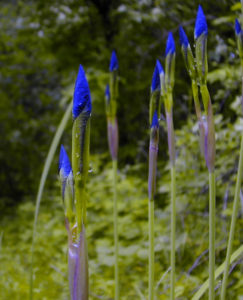Tree Books
The Audubon Society Field Guide to North American Trees, Eastern Region (Knopf, $19). A tall pocket-sized field guide with a brown plastic cover. This is a good place to start for basic all-round tree ID-ing. Good leaf and bark photos. There’s a separate Western edition too, for you folks in the Rockies and beyond.
The Trees of North America Alan Mitchell and David More (Facts On File, $35). It’s sort of a paradox, but to get a feeling for what whole trees look like (not just leaves and bark), books with photographs aren’t very good. By the time a photo is shrunk down that far you can’t see any fine detail. This book is a little expensive, but it has amazing tree paintings which are much more expressive, and have no confusing backgrounds. (If the price is too steep, most of these illustrations are also in the little American Nature Guides: Trees, also by Mitchell and More.)
Michigan Trees Barnes and Wagner (U of Mich Press, $15). For Michigan native trees this is the ultimate authority, although the black-and-white line drawings are not the most exciting. This is written by scientists in scientific jargon, but it has much more information about each tree: native range by county, growth rates, rareness, the environments each tree likes… (Non-Michiganians can probably find something similar for their state.)
A Natural History of Trees of Eastern and Central North America, Donald Culross Peattie (there’s a Western book too). I got a cheap paperback, but this book, originally from the 40’s, is a fine one to get in used bookstores. It’s laughably inadequate for tree ID-ing: The plates are lovely but rather abstract woodcuts.
But you need this book. Years before trendy “earth-friendliness,” Peattie poured out an amazing passion for trees into these books. He’s still stinging from the loss of the Northeast’s White Pine forests, a deforestation of Amazonian proportions Americans seem to have forgotten all about. Or the great Chestnut Blight: he writes like it was happening to his own family members. He talks about how certain hardwoods were the sign of fertile soils–so miles of them got plowed under for the pioneers’ farms. Needless to say, things have only gotten worse since then. Anyway, if this book doesn’t make you care about trees, nothing can.
Tree Sources:
Karmically, the grooviest thing to do would be to start from seed yourself. But this means knowing exactly the right dates to beat the squirrels to those tasty acorns, etc. Many seeds need exotic treatments, like putting them in the fridge in damp sand for four months, or they won’t sprout. Plus, this all adds 3 or 4 more years to the process of growning a reasonable-sized tree. So you’re forgiven if you’d just like to go out and buy something! Chances are your local nursery won’t have many natives–But here are some folks who can help you out by mail-order.
Little Valley Farm, 5693 Snead Creek Rd, Spring Green WI 53588. A friendly little catalog, mostly native perennials. But they have some nifty shrubs too. The elderberry I got from them was one unbelievably rugged specimen, it doubled in size the first year. Orders are sent in charmingly strange re-used cartons, along with the 1950’s-vintage pamphlet How To Plant.
Oikos Tree Crops, P.O. Box 19425, Kalamazoo MI 49019. These folks have mostly ankle-high stock, but they are about the most hard-core oak and fruit/nut tree specialists around. Their main pride seems to be hybrid oaks, which are suprisingly fast growers or heavy acorn producers. But they have most of the wild oaks too–in fact it’s the only place I’ve found which sells my fave the Chinkapin Oak. They’re also part of an active movement to raise awareness of the Paw Paw–or “Michigan Banana”–there’s even a Paw Paw Foundation in Washington! (Mine are still knee high and probably won’t bear fruit before 2001, but if we’re still around then I’ll let you know how they taste.)
Musser Forest, P.O. Box 340, Indiana PA 15701-0340. These guys seem mostly aimed at mass plantings or Christmas-tree growing–the catalog quotes prices if you need 1000 of something. But it’s the place to go if you need a crowd of 2-foot-tall conifers, for not too much money. A few suprises among the usual shade trees: they sell the wonderful Black Gum alongside all the dreaded Norway Maples and thornless Honeylocusts.
Forestfarm, 990 Tetherow Rd., Williams OR97544-9599. Forestfarm has everthing, making them the source of last resort for all your more obscure woody plants. It’s also the only nursery I know which ships everything potted. That makes shipping more expensive than with bare root plants, but it means their stuff just takes off and grows, rather than sulking for a year. But, most of the plants they offer are pretty teeny, and they have a rigid minimum order requirement.
Cold Stream Farm, 2030 Free Soil Rd., Free Soil MI 49411-9752. I’ve been meaning to try these guys: Their prices on 3-foot bare-root trees look great, they have some natives that are hard to find (like Ninebark), and just because the name Free Soil is so cool. They specialize in hybrid poplars, which are unbelievably fast-growing trees if you just need fast shade, fuel or a windbreak (I guess they fall apart after a few decades, though).


